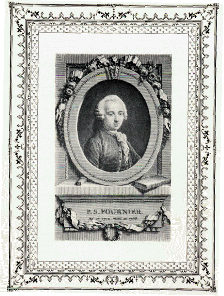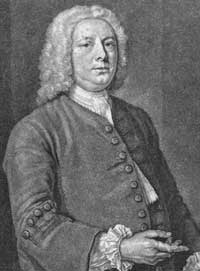|
Didone (typography)
Didone () is a genre of serif typeface that emerged in the late 18th century and was the standard style of general-purpose printing during the nineteenth. It is characterized by: * Narrow and unbracketed (hairline) serifs. (The serifs have a nearly constant width along their length.) * Vertical orientation of weight axes. (The vertical strokes of letters are thick.) * Strong contrast between thick and thin lines. (Horizontal parts of letters are thin in comparison to the vertical parts.) * Some stroke endings show ball terminals. (Many lines end in a teardrop or circle shape, rather than a plain wedge-shaped serif.) * An unornamented, "modern" appearance. The term "Didone" is a 1954 coinage, part of the Vox-ATypI classification system. It amalgamates the surnames of the famous typefounders Firmin Didot and Giambattista Bodoni, whose efforts defined the style around the beginning of the nineteenth century. The category was known in the period of its greatest popularity as modern o ... [...More Info...] [...Related Items...] OR: [Wikipedia] [Google] [Baidu] |
Pierre Simon Fournier
Pierre-Simon Fournier (15 September 1712 – 8 October 1768) was a French mid-18th century punch-cutter, typefounder and typographic theoretician. He was both a collector and originator of types. Fournier's contributions to printing were his creation of initials and ornaments, his design of letters, and his standardization of type sizes. He worked in the rococo form, and designed typefaces including Fournier and Narcissus. He was known for incorporating ‘decorative typographic ornaments’ into his typefaces. Fournier's main accomplishment is that he ‘created a standardized measuring system that would revolutionize the typography industry forever’. He was also known as Fournier le Jeune ("the younger") to distinguish him from his father Jean Claude, who was also in the typesetting industry. In his early life, Fournier studied watercolour with J. B. G. Colson, and later wood engraving. In 1737, Fournier published his first theoretical work, on the minimum spacing between le ... [...More Info...] [...Related Items...] OR: [Wikipedia] [Google] [Baidu] |
Caslon Inline Great Primer Columbia Specimen
Caslon is the name given to serif typefaces designed by William Caslon I (c. 1692–1766) in London, or inspired by his work. Caslon worked as an engraver of punches, the masters used to stamp the moulds or matrices used to cast metal type. He worked in the tradition of what is now called old-style serif letter design, that produced letters with a relatively organic structure resembling handwriting with a pen. Caslon established a tradition of engraving type in London, which previously had not been common, and was influenced by the imported Dutch Baroque typefaces that were popular in England at the time. His typefaces established a strong reputation for their quality and their attractive appearance, suitable for extended passages of text. The letterforms of Caslon's roman, or upright type include an "A" with a concave hollow at top left and a "G" without a downwards-pointing spur at bottom right. The sides of the "M" are straight. The "W" has three terminals at the top ... [...More Info...] [...Related Items...] OR: [Wikipedia] [Google] [Baidu] |
Redford & Robins - Poster - Google Art Project
Redford may refer to: Places Australia * Redford, Queensland, a locality split between the Shire of Murweh and the Maranoa Region United Kingdom * Redford, Angus * Redford, Dorset * Redford, Edinburgh * Redford, West Sussex United States * Redford, Michigan; a township ** Redford Union School District * Old Redford, Detroit, Michigan; a neighborhood * Redford, Missouri * Redford, New York * Redford, Texas People * Redford (surname) * Redford Mulock, CBE, DSO (1886–1961) Canadian Air Commodore * Redford Pennycook (born 1985), rugby player * Redford Webster (1761–1833), U.S. apothecary * Redford White (1955–2010), Filipino actor Facilities and structures * Redford Barracks, Redford, Edinburgh, Scotland, UK * Redford Union High School, Redford, Michigan, USA * Redford High School, Detroit, Michigan, USA * Redford Theatre, Detroit, Michigan, USA Other uses * Redford cabinet (2011–2014), Alberta government cabinet of Allison Redford See also * Battle of ... [...More Info...] [...Related Items...] OR: [Wikipedia] [Google] [Baidu] |
Monotype Imaging
Monotype Imaging Holdings Inc., founded as Lanston Monotype Machine Company in 1887 in Philadelphia by Tolbert Lanston, is an American (historically Anglo-American) company that specializes in digital typesetting and typeface design for use with consumer electronics devices. Incorporated in Delaware and headquartered in Woburn, Massachusetts, the company has been responsible for many developments in printing technology—in particular the Monotype machine, which was a fully mechanical hotmetal typesetter, that produced texts automatically, all single type. Monotype was involved in the design and production of many typefaces in the 20th century. Monotype developed many of the most widely used typeface designs, including Times New Roman, Gill Sans, Arial, Bembo and Albertus. Via acquisitions including Linotype GmbH, International Typeface Corporation, Bitstream, FontShop, URW and Hoefler & Co., the company has gained the rights to major font families including Helvetica, ITC Fra ... [...More Info...] [...Related Items...] OR: [Wikipedia] [Google] [Baidu] |
Stanley Morison
Stanley Arthur Morison (6 May 1889 – 11 October 1967) was a British typographer, printing executive and historian of printing. Largely self-educated, he promoted higher standards in printing and an awareness of the best printing and typefaces of the past. From the 1920s Morison became an influential adviser to the British Monotype Corporation, advising them on type design. His strong aesthetic sense was a force within the company, which starting shortly before his joining became increasingly known for commissioning popular, historically influenced designs that revived some of the best typefaces of the past, with particular attention to the middle period of printing from the Renaissance to the late eighteenth century, and creating and licensing several new type designs that would become popular. Original typefaces commissioned under Morison's involvement included Times New Roman, Gill Sans and Perpetua, while revivals of older designs included Bembo, Ehrhardt and Bell. Times N ... [...More Info...] [...Related Items...] OR: [Wikipedia] [Google] [Baidu] |
Nicolete Gray
Nicolete Gray (sometimes Nicolette Gray) (20 July 1911–8 June 1997) was a British scholar of art and calligraphy. She was the youngest daughter of the poet, dramatist and art scholar Laurence Binyon and his wife, writer, editor and translator Cicely Margaret Pryor Powell. In 1933, she married Basil Gray (1904–1989), with whom she had five children, two sons and three daughters, including Camilla Gray. She attended St Delilah's School where she won a scholarship to Lady Margaret Hall at Oxford to read History in 1929. In 1936 she curated the touring exhibition ''Abstract and Concrete'', the first showing of abstract art, and of the work of Mondrian, in England England is a country that is part of the United Kingdom. It shares land borders with Wales to its west and Scotland to its north. The Irish Sea lies northwest and the Celtic Sea to the southwest. It is separated from continental Europe b .... She taught at London's Central School of Art and D ... [...More Info...] [...Related Items...] OR: [Wikipedia] [Google] [Baidu] |
Scotch Roman
Scotch Roman is a class of typefaces popular in the early nineteenth century, particularly in the United States and to a lesser extent the United Kingdom. These typefaces were modeled on a design known as Pica No. 2 from the Edinburgh foundry of William Miller. Some accounts suggest that Miller's type, the oldest surviving specimen of which dates to 1813, was cut by Richard Austin, who had previously produced the Bell types for the British Letter Foundry. The name "Scotch Roman", which entered use in the United States late in the same century, was applied to a slightly modified recasting of Miller's type by the A.D. Farmer foundry of New York. It is believed to derive from "Scotch-face", a term which was originally used by a different type designed in 1839 by typefounder Samuel Nelson Dickinson of Boston, and cast for him by Alexander Wilson and Son in Glasgow. Versions of Scotch Roman were subsequently released by a number of other typefoundries, including both Linotype and ... [...More Info...] [...Related Items...] OR: [Wikipedia] [Google] [Baidu] |
Bulmer (typeface)
Bulmer is the name given to a serif typeface originally designed by punchcutter William Martin around 1790 for the Shakespeare Press, run by William Bulmer (1757–1830). The types were used for printing the Boydell Shakespeare folio edition. Design and history Bulmer is considered to be a late "transitional" face. Faces in this style, which became most common in the mid to late eighteenth century, were more crisply engraved than earlier faces. William Martin's typefaces show strong influence of the Baskerville typeface of John Baskerville which popularised this style in England, but with more contrast, bolder, narrower and with sharper serifs. His brother Robert Martin had worked as Baskerville's foreman and William Martin probably worked for him too. They also show influence of the crisp new "modern" faces, now called Didones, increasingly popular on the continent. The typeface used "modern" figures, a recent innovation, at nearly capital-height. Although Bulmer wrote in ... [...More Info...] [...Related Items...] OR: [Wikipedia] [Google] [Baidu] |
Bell (typeface)
Bell is the name given to a serif typeface designed and cut in 1788 by the punchcutter Richard Austin for the British Letter Foundry, operated by publisher John Bell, and revived several times since. The Bell typeface has a precise appearance that features stylish contrasts between thick and thin strokes and ball terminals on many letters; it was influenced by the radical Didone styles of type becoming popular on the continent, in particular the work of the Didot family. However, it is less severe in design, somewhat similar to the earlier Baskerville and slightly later Bulmer typefaces. The figures are distinctive for being at fixed height, or lining, at approximately three-quarter the height of the capitals, in contrast to earlier numerals of variable height. The figures have a number of elaborate details reminiscent of the steely calligraphy of the period, and the slight inclination of some of them led Walter Tracy to suggest that Austin was following a written example. In ... [...More Info...] [...Related Items...] OR: [Wikipedia] [Google] [Baidu] |
.jpg)



.jpg)

